Shimin Li
CodecBench: A Comprehensive Benchmark for Acoustic and Semantic Evaluation
Aug 28, 2025



Abstract:With the rise of multimodal large language models (LLMs), audio codec plays an increasingly vital role in encoding audio into discrete tokens, enabling integration of audio into text-based LLMs. Current audio codec captures two types of information: acoustic and semantic. As audio codec is applied to diverse scenarios in speech language model , it needs to model increasingly complex information and adapt to varied contexts, such as scenarios with multiple speakers, background noise, or richer paralinguistic information. However, existing codec's own evaluation has been limited by simplistic metrics and scenarios, and existing benchmarks for audio codec are not designed for complex application scenarios, which limits the assessment performance on complex datasets for acoustic and semantic capabilities. We introduce CodecBench, a comprehensive evaluation dataset to assess audio codec performance from both acoustic and semantic perspectives across four data domains. Through this benchmark, we aim to identify current limitations, highlight future research directions, and foster advances in the development of audio codec. The codes are available at https://github.com/RayYuki/CodecBench.
Scaling of Search and Learning: A Roadmap to Reproduce o1 from Reinforcement Learning Perspective
Dec 18, 2024



Abstract:OpenAI o1 represents a significant milestone in Artificial Inteiligence, which achieves expert-level performances on many challanging tasks that require strong reasoning ability.OpenAI has claimed that the main techinique behinds o1 is the reinforcement learining. Recent works use alternative approaches like knowledge distillation to imitate o1's reasoning style, but their effectiveness is limited by the capability ceiling of the teacher model. Therefore, this paper analyzes the roadmap to achieving o1 from the perspective of reinforcement learning, focusing on four key components: policy initialization, reward design, search, and learning. Policy initialization enables models to develop human-like reasoning behaviors, equipping them with the ability to effectively explore solution spaces for complex problems. Reward design provides dense and effective signals via reward shaping or reward modeling, which is the guidance for both search and learning. Search plays a crucial role in generating high-quality solutions during both training and testing phases, which can produce better solutions with more computation. Learning utilizes the data generated by search for improving policy, which can achieve the better performance with more parameters and more searched data. Existing open-source projects that attempt to reproduce o1 can be seem as a part or a variant of our roadmap. Collectively, these components underscore how learning and search drive o1's advancement, making meaningful contributions to the development of LLM.
Case2Code: Learning Inductive Reasoning with Synthetic Data
Jul 17, 2024



Abstract:Complex reasoning is an impressive ability shown by large language models (LLMs). Most LLMs are skilled in deductive reasoning, such as chain-of-thought prompting or iterative tool-using to solve challenging tasks step-by-step. In this paper, we hope to focus on evaluating and teaching LLMs to conduct inductive reasoning, that is, LLMs are supposed to infer underlying rules by observing examples or sequential transformations. However, collecting large-scale and diverse human-generated inductive data is challenging. We focus on data synthesis in the code domain and propose a \textbf{Case2Code} task by exploiting the expressiveness and correctness of programs. Specifically, we collect a diverse set of executable programs, synthesize input-output transformations for each program, and force LLMs to infer the underlying code implementations based on the synthetic I/O cases. We first evaluate representative LLMs on the synthesized Case2Code task and demonstrate that the Case-to-code induction is challenging for LLMs. Then, we synthesize large-scale Case2Code training samples to train LLMs to perform inductive reasoning. Experimental results show that such induction training benefits not only in distribution Case2Code performance but also enhances various coding abilities of trained LLMs, demonstrating the great potential of learning inductive reasoning via synthetic data.
Cross-Modality Safety Alignment
Jun 21, 2024Abstract:As Artificial General Intelligence (AGI) becomes increasingly integrated into various facets of human life, ensuring the safety and ethical alignment of such systems is paramount. Previous studies primarily focus on single-modality threats, which may not suffice given the integrated and complex nature of cross-modality interactions. We introduce a novel safety alignment challenge called Safe Inputs but Unsafe Output (SIUO) to evaluate cross-modality safety alignment. Specifically, it considers cases where single modalities are safe independently but could potentially lead to unsafe or unethical outputs when combined. To empirically investigate this problem, we developed the SIUO, a cross-modality benchmark encompassing 9 critical safety domains, such as self-harm, illegal activities, and privacy violations. Our findings reveal substantial safety vulnerabilities in both closed- and open-source LVLMs, such as GPT-4V and LLaVA, underscoring the inadequacy of current models to reliably interpret and respond to complex, real-world scenarios.
Unified Active Retrieval for Retrieval Augmented Generation
Jun 18, 2024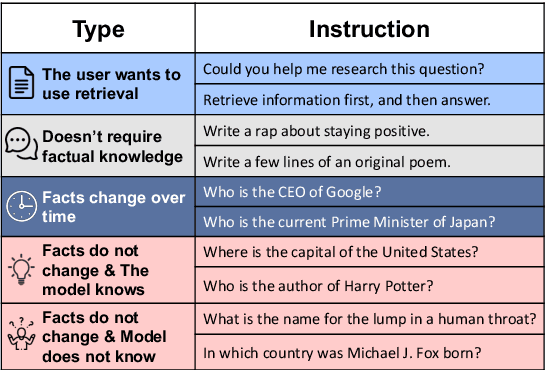

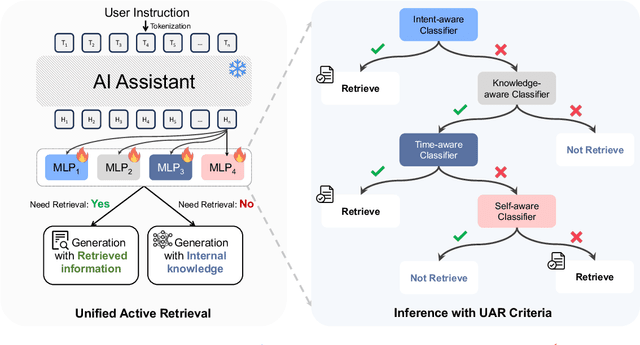
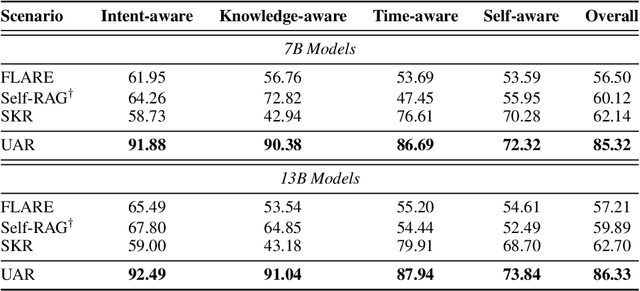
Abstract:In Retrieval-Augmented Generation (RAG), retrieval is not always helpful and applying it to every instruction is sub-optimal. Therefore, determining whether to retrieve is crucial for RAG, which is usually referred to as Active Retrieval. However, existing active retrieval methods face two challenges: 1. They usually rely on a single criterion, which struggles with handling various types of instructions. 2. They depend on specialized and highly differentiated procedures, and thus combining them makes the RAG system more complicated and leads to higher response latency. To address these challenges, we propose Unified Active Retrieval (UAR). UAR contains four orthogonal criteria and casts them into plug-and-play classification tasks, which achieves multifaceted retrieval timing judgements with negligible extra inference cost. We further introduce the Unified Active Retrieval Criteria (UAR-Criteria), designed to process diverse active retrieval scenarios through a standardized procedure. Experiments on four representative types of user instructions show that UAR significantly outperforms existing work on the retrieval timing judgement and the performance of downstream tasks, which shows the effectiveness of UAR and its helpfulness to downstream tasks.
SpeechAlign: Aligning Speech Generation to Human Preferences
Apr 08, 2024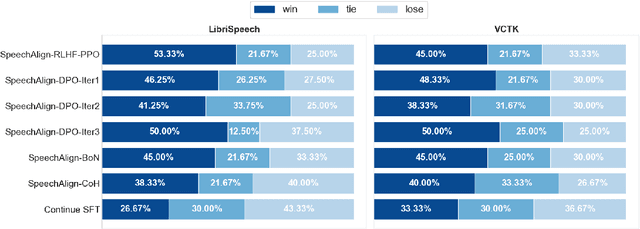
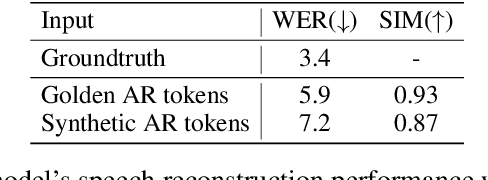
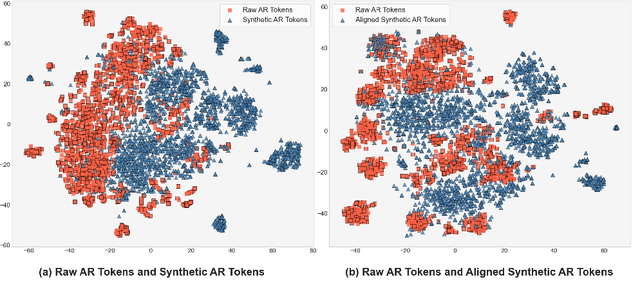

Abstract:Speech language models have significantly advanced in generating realistic speech, with neural codec language models standing out. However, the integration of human feedback to align speech outputs to human preferences is often neglected. This paper addresses this gap by first analyzing the distribution gap in codec language models, highlighting how it leads to discrepancies between the training and inference phases, which negatively affects performance. Then we explore leveraging learning from human feedback to bridge the distribution gap. We introduce SpeechAlign, an iterative self-improvement strategy that aligns speech language models to human preferences. SpeechAlign involves constructing a preference codec dataset contrasting golden codec tokens against synthetic tokens, followed by preference optimization to improve the codec language model. This cycle of improvement is carried out iteratively to steadily convert weak models to strong ones. Through both subjective and objective evaluations, we show that SpeechAlign can bridge the distribution gap and facilitating continuous self-improvement of the speech language model. Moreover, SpeechAlign exhibits robust generalization capabilities and works for smaller models. Code and models will be available at https://github.com/0nutation/SpeechGPT.
LLM can Achieve Self-Regulation via Hyperparameter Aware Generation
Feb 17, 2024Abstract:In the realm of Large Language Models (LLMs), users commonly employ diverse decoding strategies and adjust hyperparameters to control the generated text. However, a critical question emerges: Are LLMs conscious of the existence of these decoding strategies and capable of regulating themselves? The current decoding generation process often relies on empirical and heuristic manual adjustments to hyperparameters based on types of tasks and demands. However, this process is typically cumbersome, and the decoding hyperparameters may not always be optimal for each sample. To address the aforementioned challenges, we propose a novel text generation paradigm termed Hyperparameter Aware Generation (HAG). By leveraging hyperparameter-aware instruction tuning, the LLM autonomously determines the optimal decoding strategy and configs based on the input samples, enabling self-regulation. Our approach eliminates the need for extensive manual tuning, offering a more autonomous, self-regulate model behavior. Experimental results spanning six datasets across reasoning, creativity, translation, and mathematics tasks demonstrate that hyperparameter-aware instruction tuning empowers the LLMs to self-regulate the decoding strategy and hyperparameter. HAG extends the current paradigm in the text generation process, highlighting the feasibility of endowing the LLMs with self-regulate decoding strategies.
Can AI Assistants Know What They Don't Know?
Jan 28, 2024



Abstract:Recently, AI assistants based on large language models (LLMs) show surprising performance in many tasks, such as dialogue, solving math problems, writing code, and using tools. Although LLMs possess intensive world knowledge, they still make factual errors when facing some knowledge intensive tasks, like open-domain question answering. These untruthful responses from the AI assistant may cause significant risks in practical applications. We believe that an AI assistant's refusal to answer questions it does not know is a crucial method for reducing hallucinations and making the assistant truthful. Therefore, in this paper, we ask the question "Can AI assistants know what they don't know and express them through natural language?" To answer this question, we construct a model-specific "I don't know" (Idk) dataset for an assistant, which contains its known and unknown questions, based on existing open-domain question answering datasets. Then we align the assistant with its corresponding Idk dataset and observe whether it can refuse to answer its unknown questions after alignment. Experimental results show that after alignment with Idk datasets, the assistant can refuse to answer most its unknown questions. For questions they attempt to answer, the accuracy is significantly higher than before the alignment.
SpeechGPT-Gen: Scaling Chain-of-Information Speech Generation
Jan 25, 2024Abstract:Benefiting from effective speech modeling, current Speech Large Language Models (SLLMs) have demonstrated exceptional capabilities in in-context speech generation and efficient generalization to unseen speakers. However, the prevailing information modeling process is encumbered by certain redundancies, leading to inefficiencies in speech generation. We propose Chain-of-Information Generation (CoIG), a method for decoupling semantic and perceptual information in large-scale speech generation. Building on this, we develop SpeechGPT-Gen, an 8-billion-parameter SLLM efficient in semantic and perceptual information modeling. It comprises an autoregressive model based on LLM for semantic information modeling and a non-autoregressive model employing flow matching for perceptual information modeling. Additionally, we introduce the novel approach of infusing semantic information into the prior distribution to enhance the efficiency of flow matching. Extensive experimental results demonstrate that SpeechGPT-Gen markedly excels in zero-shot text-to-speech, zero-shot voice conversion, and speech-to-speech dialogue, underscoring CoIG's remarkable proficiency in capturing and modeling speech's semantic and perceptual dimensions. Code and models are available at https://github.com/0nutation/SpeechGPT.
Agent Alignment in Evolving Social Norms
Jan 20, 2024



Abstract:Agents based on Large Language Models (LLMs) are increasingly permeating various domains of human production and life, highlighting the importance of aligning them with human values. The current alignment of AI systems primarily focuses on passively aligning LLMs through human intervention. However, agents possess characteristics like receiving environmental feedback and self-evolution, rendering the LLM alignment methods inadequate. In response, we propose an evolutionary framework for agent evolution and alignment, named EvolutionaryAgent, which transforms agent alignment into a process of evolution and selection under the principle of survival of the fittest. In an environment where social norms continuously evolve, agents better adapted to the current social norms will have a higher probability of survival and proliferation, while those inadequately aligned dwindle over time. Experimental results assessing the agents from multiple perspectives in aligning with social norms demonstrate that EvolutionaryAgent can align progressively better with the evolving social norms while maintaining its proficiency in general tasks. Effectiveness tests conducted on various open and closed-source LLMs as the foundation for agents also prove the applicability of our approach.
 Add to Chrome
Add to Chrome Add to Firefox
Add to Firefox Add to Edge
Add to Edge